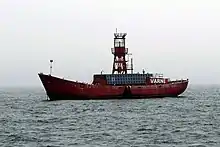Varne Bank
The Varne Bank or Varne Shoal is a 5+3⁄4-mile (9.3 km) long sand bank in the Strait of Dover, lying 9 miles (14 km) southwest of Dover in Kent, England.[1][2] With the Lobourg Channel running along it, the Varne bank lies immediately south-west of the deepest point 223 feet (68 m) in the strait of Dover. Its rectilinear shape is similar to other banks in the strait such as South Falls bank bordering the Lobourg Channel on the east, the Colbart bank (a.k.a. the Ridge) and others. Rectilinear-shaped banks are only present on the English side of the strait.[3]
Lying almost in the middle of the south/west international traffic English-side channel of the English Channel, the Varne Bank is a constant concern for both British coastguards and shipping.[4] The sea above it presents strong rippling, especially when strong tides occur, and is noted for its extra roughness during bad weather.[5]
With a minimum depth of about 2 metres (7 ft), it is marked by Trinity House with lighted buoys at the North, South, East and West.[6] Due to its heightened risk, they have additionally marked the Varne Bank with a lightvessel since October 1860, initially located "near the west end of the Varne Shoal", 9 nautical miles (17 km) south of Folkestone church;[7][8][9] over time it has been placed at various positions, and is now off its north-eastern end.[6][10]

Varne Bank in the Dover Strait
Ships that founder on the Varne Bank are often stated as being lost on the Goodwin Sands in error, perhaps because the Varne Bank is less well known than its close northerly neighbour. Due to the volume increase in shipping through the world's busiest channel, several proposals have been made to eliminate the Varne Bank through dredging.[11] However, also due to its shallow depth, the Varne Bank is a productive location for fishing, especially for cod and scallops.
In 1802, mining engineer Albert Mathieu made proposals to Napoleon for turning the Varne Bank into an island staging point for the Channel Tunnel.
In the 20th century, a proposal was made for a Channel bridge, which would have used the Varne Bank as a staging post for a support structure.
Several naval battles have been fought nearby, including the Battle of Dover and Battle of Dungeness in 1652 and the Battle of Dover Strait in 1917.[12]
The Varne Bank along with its neighbouring bank Colbart, the Vergoyer bank, the ridens (fr) de Boulogne and the French side of the Bassurelle bank, form part of a 262 square miles (680 km2) Natura 2000 protection zone listed under the name « Ridens et dunes hydrauliques du détroit du Pas de Calais » ("Underwater ridges and dunes of the strait of Pas de Calais").[13]
References
-
Chandler, John; et al. (1809). The new seaman's guide and coaster's companion, improved from the original. London: P. Mason. p. 21. Retrieved 3 January 2008.
varne.
- An actual survey of the Varne & Ridge; taken by order of John MacBride, Esqr, Rear Admiral of the Blue and Commander in Chief in the Downs &c (Map). Sayer, London. 1793. Retrieved 7 May 2014.
- CoastView - What happens offshore?. GEOSYNTH-Project - University of Sussex.
- Cargo ship rescued by high tide BBC News - 27 April 2006
- Sailing Directions for the North Coast of France. London: Imray, Laurie, Norie & Wilson. 1908. pp. 1–2. Retrieved 21 January 2023.
- Gaspar, Roger (2014). Crossing the Thames Estuary (PDF) (2nd, online update ed.). St. Ives, Cambridgeshire: Imray, Laurie, Norie & Wilson. ISBN 9781846236280. Archived from the original (PDF) on 21 January 2023. Retrieved 21 January 2023.
- "Varne Lightvessel". Trinity House. London: Corporation of Trinity House. Archived from the original on 4 February 2022. Retrieved 21 October 2022.
- "New Lightvessel near the Varne Shoal, Straits of Dover". Lloyd's List. No. 14, 510. London. 5 October 1860. p. 1. Retrieved 21 October 2022 – via British Newspaper Archive.
- King, John W. (1863). The Channel Pilot, Part I (2nd ed.). London: The Admiralty. pp. 229–230. Retrieved 21 January 2023.
- "Varne LV". MarineTraffic. Archived from the original on 21 January 2023. Retrieved 21 January 2023.
- Commodore David Squire - The Hazards of Navigating The Dover Strait (Pas-de-Calais) Traffic Separation Scheme - Cambridge Journal, 2003
- History of Folkestone Harbour and Cross Channel Links www.folkestoneharbour.com
- "Ridens et dunes hydrauliques du détroit du Pas-de-Calais". Inventaire national du patrimoine naturel (in French). Paris: Muséum National d’Histoire Naturelle. July 2022. Archived from the original on 6 October 2022. Retrieved 21 January 2023.